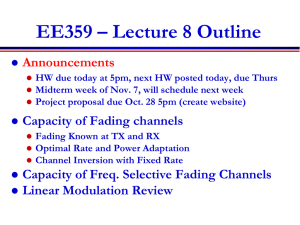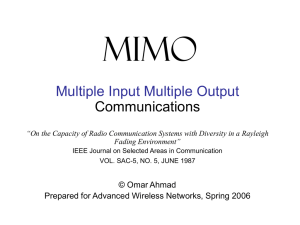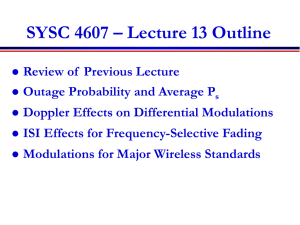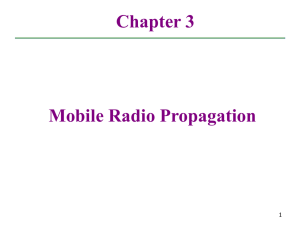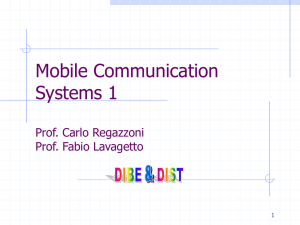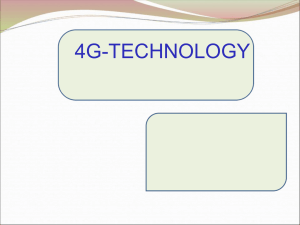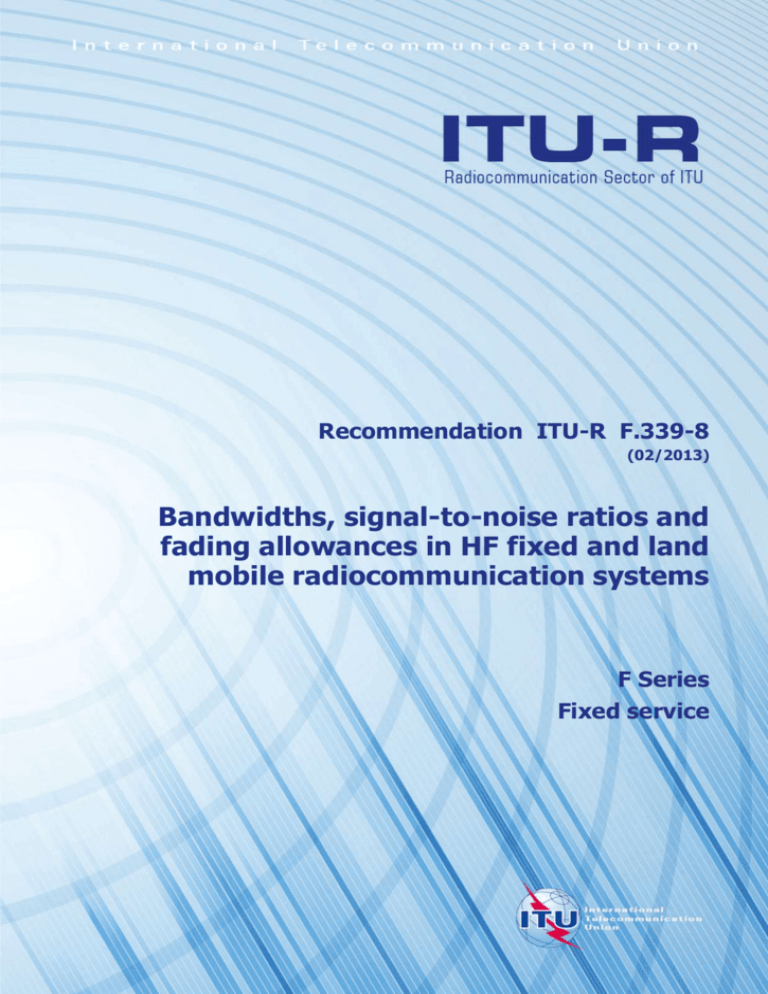
Recommendation ITU-R F.339-8
(02/2013)
Bandwidths, signal-to-noise ratios and
fading allowances in HF fixed and land
mobile radiocommunication systems
F Series
Fixed service
ii
Rec. ITU-R F.339-8
Foreword
The role of the Radiocommunication Sector is to ensure the rational, equitable, efficient and economical use of the
radio-frequency spectrum by all radiocommunication services, including satellite services, and carry out studies without
limit of frequency range on the basis of which Recommendations are adopted.
The regulatory and policy functions of the Radiocommunication Sector are performed by World and Regional
Radiocommunication Conferences and Radiocommunication Assemblies supported by Study Groups.
Policy on Intellectual Property Right (IPR)
ITU-R policy on IPR is described in the Common Patent Policy for ITU-T/ITU-R/ISO/IEC referenced in Annex 1 of
Resolution ITU-R 1. Forms to be used for the submission of patent statements and licensing declarations by patent
holders are available from http://www.itu.int/ITU-R/go/patents/en where the Guidelines for Implementation of the
Common Patent Policy for ITU-T/ITU-R/ISO/IEC and the ITU-R patent information database can also be found.
Series of ITU-R Recommendations
(Also available online at http://www.itu.int/publ/R-REC/en)
Series
BO
BR
BS
BT
F
M
P
RA
RS
S
SA
SF
SM
SNG
TF
V
Title
Satellite delivery
Recording for production, archival and play-out; film for television
Broadcasting service (sound)
Broadcasting service (television)
Fixed service
Mobile, radiodetermination, amateur and related satellite services
Radiowave propagation
Radio astronomy
Remote sensing systems
Fixed-satellite service
Space applications and meteorology
Frequency sharing and coordination between fixed-satellite and fixed service systems
Spectrum management
Satellite news gathering
Time signals and frequency standards emissions
Vocabulary and related subjects
Note: This ITU-R Recommendation was approved in English under the procedure detailed in Resolution ITU-R 1.
Electronic Publication
Geneva, 2013
ITU 2013
All rights reserved. No part of this publication may be reproduced, by any means whatsoever, without written permission of ITU.
Rec. ITU-R F.339-8
1
RECOMMENDATION ITU-R F.339-8
Bandwidths, signal-to-noise ratios and fading allowances in
HF fixed and land mobile radiocommunication systems
(1951-1953-1956-1963-1966-1970-1974-1978-1982-1986-2006-2013)
Scope
This Recommendation shows selected examples of various HF (3-30 MHz) fixed and land mobile service
systems that are currently in use and describes the key system parameters (bandwidths, signal-to-noise
density ratios and fading allowances) for these systems. The system parameters should be used in the
deployment of HF systems and could be used in sharing studies.
The ITU Radiocommunication Assembly,
considering
a)
deal;
that it is desirable to classify the technical aspects with which future studies will have to
b)
that there is a need for numerical values which take into account fading and fluctuations in
field intensity;
c)
that, however, the information contained in Annex 1 to Recommendation ITU-R P.313
gives some results from which provisional data on fading conditions can be derived;
d)
that there are a large variety of HF fixed and land mobile systems in operation or being
developed to meet future requirements. Consequently, there is no one single “typical” system as a
general purpose model,
recommends
1
that the values given in Tables 1 to 4 of Annex 1 should be used for the signal-to-noise
density ratio (SNR) required for the class of emission concerned;
2
that the values given in the fading condition columns of Table 1 in Annex 1, in conjunction
with the estimate of the intensity fluctuation factor given in Note 4 to Table 1, may be used as an
aid to estimate monthly-median values of hourly-median field intensities necessary for the various
types and grades of service;
3
that the Note shown below should be considered part of this Recommendation.
NOTE – Use of the recommended values only provides an estimate to be obtained, which may have
to be adjusted for radio circuits of different path lengths depending on the grade of service required.
2
Rec. ITU-R F.339-8
Annex 1
TABLE 1
Required signal-to-noise ratios
Average RF SNR(2)(3) (dB/Hz)
Class of emission
A1 A Telegraphy 8 Bd
PrePostdetection detection
bandwidth bandwidth
of receiver of receiver
(Hz)
(Hz)
3 000
1 500
Grade of service
Fading
condition
(4)
(5)
Dual
diversity
–4
31
16
40
58
10
38
49
–4
35
38
11
50
56
Error!
Error!
Error!
(10)
43
52
Error!
23
24
26
Error!
29
34
39
Error!
26
27
29
Error!
32
36
42
Error!
25
26
28
Error!
31
35
41
50
59
15
20
50
55
58
65
6;15;33 } (18)
50
59
67(14)
Error!
Error!
6;15;33 } (18)
Error!
Error!
Error!
6;15;33 } (18)
Error!
Error!
Error!
6;15;33 } (18)
47
56
64(14)
Error!
Error!
6;15;33 } (18)
49
58
66(14)
Error!
Error!
(6)
Aural reception
250
250
A1 B Telegraphy
120 Bd, undulator
600
600
A2 A Telegraphy 8 Bd
3 000
1 500
Aural reception
A2 B Telegraphy 24 Bd
3 000
1 500
Commercial grade
F1 B Telegraphy
50 Bd, printer
2D 200 Hz to 400 Hz
1 500
100
300
300
F1 B Telegraphy
200 Bd, printer
2D 400 Hz, ARQ
Stable
condition
Nondiversity
A1 B Telegraphy 50 Bd,
printer
F1 B Telegraphy
100 Bd, printer
2D 170 Hz, ARQ
Audio
SNR(1)
(dB)
Commercial grade
(7)
(6) (19)
(7) (19)
38
Error!
(10)
F1B Telegraphy
MFSK 33-tone
ITA2 10 character/s
400
400
F1B Telegraphy
MFSK 12-tone
ITA5 10 character/s
300
300
F1B Telegraphy
MFSK 6-tone
ITA2 10 character/s
180
180
3 000
3 000
R3C Phototelegraphy
60 rpm
1 100
3 000
A3E Telephony double
sideband
6 000
3 000
F7B Telegraphy
R3C Phototelegraphy
60 rpm
H3E Telephony singlesideband full carrier
R3E Telephony singlesideband reduced carrier
J3E Telephony singlesideband suppressed carrier
B8E Telephony
independent-sideband
2 channels
3 000
3 000
3 000
6 000
3 000
3 000
3 000
3 000
per
channel
Marginally commercial
Good commercial
(22)
Just usable
Marginally commercial
Good commercial
(11)
Just usable
Marginally commercial
Good commercia l
(11)
Just usable
Marginally commercial
Good commercial
(11)
Just usable
Marginally commercial
Good commercial
(11)
Just usable
Marginally commercial
Good commercial
(11)
(22)
(12)
(13)
(12)
(13)
(12)
(13)
(12)
(13)
(12)
(13)
Rec. ITU-R F.339-8
3
TABLE 1 (continued)
Average RF SNR(2)(3) (dB/Hz)
Class of emission
PrePostdetection detection
bandwidth bandwidth
of receiver of receiver
(Hz)
(Hz)
B8E Telephony
independent-sideband
4 channels
12 000
J7B Multichannel
V.F. telegraphy
16 channels 75 Bd each
3 000
110
per
channel
3 000
110
per
channel
J7B Multichannel
V.F. telegraphy
15 channels 100 Bd each
with ARQ
3 000
per
channel
Audio
SNR(1)
(dB)
Grade of service
Just usable
Marginally commercial
Good commercial
(11)
(12)
6;15;33 } (18)
(13)
Error!
Stable
condition
Fading
condition
(4)
(5)
Nondiversity
Dual
diversity
50
59
67(14)
Error!
Error!
Error!
Error!
Error!
Error!
Error!
Error!
(10)
R7B Multichannel
V.F. telegraphy
reduced carrier
B7W Composite
16 channels 75 Bd each
1 telephony channel (16)
6 000
110 per
telegraphy
channel
3 000 for the
telephony
channel
Error!
(1)
Noise bandwidth equal to post-detection bandwidth of receiver. For an independent-sideband telephony noise bandwidth equal to the
post-detection bandwidth of one channel.
(2)
The figures in this column of Table 1 represent the ratio of signal peak envelope power to the average noise power in a 1 Hz bandwidth except for
double-sideband A3E emission where the figures represent the ratio of the carrier power to the average noise power in a 1 Hz bandwidth.
(3)
The values of the radio-frequency signal-to-noise density ratio for telephony listed in this column, apply when conventional terminals are used.
They can be reduced considerably (by amounts as yet undetermined) when terminals of the type using linked compressor expanders (Lincompex)
are used (see Recommendation ITU-R F.1111). A speech-to-noise (r.m.s. voltage) ratio of 7 dB measured at audio-frequency in a 3 kHz band has
been found to correspond to just marginally commercial quality at the output of the system, taking into account the compandor improvement.
(4)
The values in these columns represent the median values of the fading signal power necessary to yield an equivalent grade of service, and do not
include the intensity fluctuation factor (allowance for day-to-day fluctuation). In general, a value of 11.5 dB may be added as the intensity
fluctuation factor to the values in these columns to arrive at provisional values for the total required signal-to-noise density ratios which may be
used as a guide to estimate required monthly-median values of hourly-median field strength. This value of 11.5 dB has been obtained as follows:
The intensity fluctuation factor for the signal, against steady noise, is 10 dB, estimated to give protection for 90% of the days. The fluctuations in
intensity of atmospheric noise are also taken to be 10 dB for 90% of the days. Assuming that there is no correlation between the fluctuations in
intensity of the noise and those of the signal, a good estimate of the combined signal and noise intensity fluctuation factor is:
10 log 102 102 11.5 dB
(5)
In calculating the radio-frequency signal-to-noise density ratios for rapid short-period fading, a log-normal amplitude distribution of the received
fading signal has been used (using 7 dB for the ratio of median level to level exceeded for 10% or 90% of the time) except for high-speed
automatic telegraphy services, where the protection has been calculated on the assumption of a Rayleigh distribution. Notes (6) to (25) refer to
protection against rapid or short-period fading.
(6)
For protection 90% of the time.
(7)
For A1B telegraphy, 50 baud printer: for protection 99.99% of the time. For A2B telegraphy, 24 bauds: for protection 98% of the time.
(8)
The symbol PC stands for the probability of character error.
(9)
Atmospheric noise (Vd 6 dB) is assumed.
(10)
Based on 90% traffic efficiency.
(11)
For 90% sentence intelligibility.
(12)
When connected to the public service network: based on 80% protection.
4
Rec. ITU-R F.339-8
Notes relative to Table 1 (end):
(13)
When connected to the public service network: based on 90% protection.
(14)
Assuming 10 dB improvement due to the use of noise reducers.
(15)
Diversity improvement based on a wide-spaced (several kilometres) diversity.
(16)
Transmitter loading of 80% of the rated peak envelope power of the transmitter by the multi-channel telegraph signal is assumed.
(17)
Required signal-to-noise density ratio based on performance of telegraphy channels.
(18)
For telephony, the figures in this column represent the ratio of the audio-frequency signal, as measured on a standard VU-meter, to the r.m.s.
noise, for a bandwidth of 3 kHz. (The corresponding peak signal power, i.e. when the transmitter is 100% tone-modulated, is assumed to be 6 dB
higher.)
(19)
Total sideband power, combined with keyed carrier, is assumed to give partial (two element) diversity effect. An allowance of 4 dB is made for
90% protection (8 bauds), and 6 dB for 98% protection (24 bauds).
(20)
Used if Lincompex terminals will reduce these figures by an amount yet to be determined.
(21)
For fewer channels these figures will be different. The relationship between the number of channels and the required signal-to-noise ratio has yet
to be determined.
(22)
Quality judged in accordance with Recommendation ITU-T T.22 – Standardized test charts for document facsimile transmissions.
(23)
For class of emission H3E the levels of sideband signals and pilot-carrier corresponding to 100% modulation are each – 6 dB relative peak
envelope power (p.e.p.). SSB receiver used for reception.
(24)
For class of emission R3E the pilot-carrier level of – 20 dB relative to p.e.p. is applied and the level of the sideband signal corresponding to 100%
modulation is 1 dB lower than the p.e.p.
(25)
Dependent on fading rate, typical values shown.
TABLE 2
Required average SNRs for 39-tone QDPSK HF modem (J2D Class of emission)
a)
BER
Average SNR
(dB/Hz)
Data rate 2 400 bit/s
AWGN channel(d)
Data rate 1 200 bit/s
Fading
condition(a) (b) (c)
AWGN channel(d)
Fading
condition(a) (b) (c)
39
8.6 10–2
6.4 10–2
44
3.5 10–2
4.4 10–3
49
1.0 10–2
3.4 10–4
54
1.0 10–3
9.0 10–6
64
1.8 10–4
2.7 10–6
b)
BER
Average SNR
(dB/Hz)
Data rate 300 bit/s
AWGN channel(d)
Fading
condition(a) (b) (c)
Data rate 75 bit/s
AWGN channel(d)
Fading
condition(a) (b) (c)
34
1.8 10–2
4.4 10–4
36
6.4 10–3
5.0 10–5
38
1.0 10–3
1.0 10–6
40
5.0 10–5
1.0 10–6
42
1.5 10–6
1.0 10–6
Rec. ITU-R F.339-8
5
Notes relative to Table 2 (end):
(a)
Two independent equal average power Rayleigh fading paths, with a fixed 2 ms delay between paths,
with 1 Hz fading.
(b)
(c)
72-frame “very long” interleaver.
The values in these columns represent the RMS values of the fading signal power necessary to yield an
equivalent grade of service.
(d)
“AWGN”: Un-faded channel with additive white Gaussian noise.
TABLE 3
Required average SNRs for data rates and modulation shown (J2D Class of Emission)
a)
Average SNR (dB/Hz)
User data
rate (bit/s)
BER 1.0 10–4
Modulation
AWGN
channel(d)
BER 1.0 10–5
Fading
condition
AWGN
channel(d)
(a) (b) (c)
Fading
condition
(a) (b) (c)
12 800
64-QAM
61
–
62
–
9 600
64-QAM
55
64
56
66
8 000
32-QAM
53
60
53
62
6 400
16-QAM
50
57
50
58
4 800
8-PSK
47
54
48
55
3 200
QPSK
43
48
43
49
b)
Average SNR (dB/Hz)
User data
rate (bit/s)
BER < 1.0 10–2
Modulation
AWGN
channel(d)
Fading
condition
BER < 1.0 10–3
AWGN
channel(d)
(a) (b) (c)
1 200
8-PSK
43
2 400
8-PSK
44
3 600
8-PSK
51
Fading
condition
(a) (b) (c)
44
54
49
49
59
54
53
74
(a)
Two independent equal average power Rayleigh fading paths, with a fixed 2 ms delay between paths,
with 1 Hz fading.
(b)
(c)
72-frame “very long” interleaver.
The values in these columns represent the RMS values of the fading signal power necessary to yield
an equivalent grade of service.
(d)
“AWGN”: Un-faded channel with additive white Gaussian noise.
6
Rec. ITU-R F.339-8
TABLE 4a
Data rates and modulation (J2D Class of Emission) in 3 to 24 kHz bandwidths
for scalable digital modulation system
Data rate (bit/s)
Waveform
number
Modulation
3
(kHz)
6
(kHz)
9
(kHz)
12
(kHz)
15
(kHz)
18
(kHz)
21
(kHz)
24
(kHz)
0
Walsh
75
150
300
300
300
600
300
600
1
BPSK
150
300
600
600
600
1 200
600
1 200
2
BPSK
300
600
1 200
1 200
1 200
2 400
1 200
2 400
3
BPSK
600
1 200
2 400
2 400
2 400
4 800
2 400
4 800
4
BPSK
1 200
2 400
–
4 800
4 800
–
4 800
9 600
5
BPSK
1 600
3 200
4 800
6 400
8 000
9 600
9 600
12 800
6
QPSK
3 200
6 400
9 600
12 800
16 000
19 200
19 200
25 600
7
8-PSK
4 800
9 600
14 400
19 200
24 000
28 800
28 800
38 400
8
16-QAM
6 400
12 800
19 200
25 600
32 000
38 400
38 400
51 200
9
32-QAM
8 000
16 000
24 000
32 000
40 000
48 000
48 000
64 000
10
64-QAM
9 600
19 200
28 800
38 400
48 000
57 600
57 600
76 800
11
64-QAM
12 000
24 000
36 000
48 000
57 600
72 000
76 800
96 000
12
256-QAM
16 000
32 000
48 000
64 000
76 800
90 000
115 200
120 000
13
QPSK
2 400
TABLE 4b
Required SNRs (dB/Hz) in 3 to 24 kHz bandwidths for scalable digital modulation
system for BER ≤ 1.0 10–5(e)
3 (kHz)(a)
Bandwidth
6 (kHz)(a)
9 (kHz)(a)
12 (kHz)(a)
AWGN
channel
Fading
channel
AWGN
channel
Fading
channel
AWGN
channel
Fading
channel
AWGN
channel
Fading
channel
(b)
(c) (d)
(b)
(c) (d)
(b)
(c) (d)
(b)
(c) (d)
0
29
34
32
37
34
40
35
40
1
32
38
35
41
37
43
38
44
2
35
40
38
43
40
45
41
46
3
38
42
41
45
44
48
44
48
4
40
45
43
48
–
–
46
51
5
41
46
44
49
46
51
47
52
6
44
49
47
52
49
54
50
55
7
48
54
51
57
53
59
54
60
8
51
58
54
61
56
63
57
64
9
54
62
57
65
59
67
60
68
10
56
66
59
69
61
71
62
72
11
59
–
62
–
64
–
65
–
12
65
–
68
–
70
–
71
–
13
41
46
–
–
–
–
–
–
Waveform
number
Rec. ITU-R F.339-8
7
TABLE 4b (end)
15 (kHz)(a)
Bandwidth
18 (kHz)(a)
21(kHz)(a)
24 (kHz)(a)
AWGN
channel
Fading
channel
AWGN
channel
Fading
channel
AWGN
channel
Fading
channel
AWGN
channel
Fading
channel
(b)
(c) (d)
(b)
(c) (d)
(b)
(c) (d)
(b)
(c) (d)
0
36
41
37
42
37
42
38
43
1
39
45
40
46
40
46
41
47
2
42
47
43
48
43
48
44
49
3
45
49
46
50
46
50
47
51
4
47
52
–
–
48
53
49
54
5
48
53
49
54
49
54
50
55
6
51
56
52
57
52
57
53
58
7
55
61
56
62
56
62
57
63
8
58
65
59
66
59
66
60
67
9
61
69
62
70
62
70
63
71
10
63
73
64
74
64
74
65
78
11
66
–
67
–
67
–
68
–
12
72
–
73
–
73
–
74
–
13
–
–
–
–
–
–
–
–
Waveform
number
(a)
The figures in columns of Table 4b represent the ratio of average signal power to the average noise power (dB) in
a 1 Hz bandwidth.
(b)
“AWGN”: Un-faded channel with additive white Gaussian noise.
(c)
“Fading channel”: Two independent equal average power Rayleigh fading paths, with a fixed 2 ms delay between
paths, with 1 Hz fading (corresponds to Mid-latitudes “disturbed conditions” in Recommendation ITU-R F.1487).
(d)
The values in Table 4b “Fading channel” columns represent the median values of the fading signal power
necessary to yield an equivalent grade of service.
(e)
The waveform numbers 11 and 12 are suitable for groundwave channels and skywave fading values are not
available. The waveform number 4 is not available in 9 or 18 kHz channels, and waveform number 13 is only
available in a 3 kHz bandwidth system.
Table 4 presents digital modulation for wider bandwidth HF systems. Tables 4a and 4b are to be
used together, first identify waveform number for the bandwidth and data rate of a particular system
from Table 4a then use Table 4b to determine the required signal-to-noise ratio.
An example for the use of Tables 4 for a data rate of 38 400 bits/s in 24 kHz bandwidth is shown
below:
1)
From Table 4a find the 24 kHz bandwidth column and determine the waveform number for
38 400 bit/s, which is waveform number 7 in this case.
2)
Find the row for waveform number 7 in Table 4b and find its intersection with the 24 kHz
bandwidth column.
3)
For a grade of service BER of 1 × 10–5, the required SNRs are 57 and 63 dB/Hz in
non-fading and fading channels respectively, which are presented in Table 4b.

